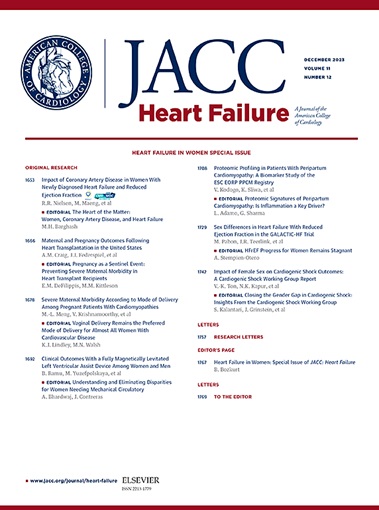Patiromer for Heart Failure Medication Optimization in Patients With Current or Past Hyperkalemia
IF 10.3
1区 医学
Q1 CARDIAC & CARDIOVASCULAR SYSTEMS
引用次数: 0
Abstract
Background
For heart failure with reduced ejection fraction (HFrEF), suboptimal use of renin-angiotensin-aldosterone system inhibitors (RAASis), including mineralocorticoid receptor antagonists (MRAs), due to hyperkalemia, may be improved by potassium binders.
Objectives
This prespecified analysis of the phase 3 DIAMOND (Patiromer for the Management of Hyperkalemia in Subjects Receiving RAASi Medications for the Treatment of Heart Failure) trial assessed the effect of patiromer in patients with HFrEF and either current or past hyperkalemia.
Methods
Patients with HFrEF and current or past (within 1 year before enrollment) hyperkalemia (serum potassium [sK+] >5.0 mmol/L) entered a single-blind, run-in phase to optimize RAASis while receiving patiromer. They were subsequently randomized, double-blind, to continue patiromer or change to placebo.
Results
Of the 1,038 patients who completed run-in, 354 (83.9%) of 422 with current hyperkalemia and 524 (85.1%) of 616 with past hyperkalemia achieved RAASi optimization and were randomized to treatment. During the double-blind phase, patiromer lowered sK+ levels compared with placebo in both the current and past hyperkalemia subgroups: difference in adjusted mean change from baseline: –0.12 (95% CI: –0.17 to –0.07) and –0.08 (95% CI: –0.12 to –0.05), respectively; Pinteraction = 0.166. Patiromer was more effective than placebo in maintaining MRA at target dose in patients with current vs past hyperkalemia (HR: 0.45 [95% CI: 0.26-0.76] vs HR: 0.85 [95% CI: 0.54-1.32]; Pinteraction = 0.031). Adverse events were similar between subgroups.
Conclusions
The use of patiromer facilitates achieving target doses of RAASis in patients with HFrEF with either current or past hyperkalemia. For those with current hyperkalemia before RAASi optimization, use of patiromer may be more beneficial in helping to maintain sK+ control and achieve MRA target dose. (Patiromer for the Management of Hyperkalemia in Subjects Receiving RAASi Medications for the Treatment of Heart Failure [DIAMOND]; NCT03888066)
帕替洛尔用于当前或既往有高钾血症的心力衰竭患者的用药优化:DIAMOND子分析
背景:对于射血分数降低的心力衰竭(HFrEF)患者来说,由于高钾血症而导致肾素-血管紧张素-醛固酮系统抑制剂(RAASis)(包括矿物质皮质激素受体拮抗剂(MRAs))使用效果不佳的情况可能会通过钾结合剂得到改善:这项对 DIAMOND(帕替洛尔用于治疗接受 RAASi 药物治疗的心力衰竭患者的高钾血症)3 期试验的预设分析评估了帕替洛尔对目前或过去患有高钾血症的 HFrEF 患者的作用:HFrEF和当前或过去(入组前1年内)患有高钾血症(血清钾[sK+]>5.0 mmol/L)的患者进入单盲磨合期,在接受帕替洛尔治疗的同时优化RAAS治疗。随后对他们进行双盲随机分组,继续服用帕替洛尔或改用安慰剂:结果:在完成磨合期的 1,038 名患者中,422 名目前患有高钾血症的患者中有 354 人(83.9%)和 616 名既往患有高钾血症的患者中有 524 人(85.1%)达到了 RAASi 的优化效果,并被随机分配接受治疗。在双盲阶段,与安慰剂相比,帕替洛尔可降低当前和既往高钾血症亚组的sK+水平:调整后的平均基线变化差异分别为-0.12(95% CI:-0.17至-0.07)和-0.08(95% CI:-0.12至-0.05);Pinteraction = 0.166。与安慰剂相比,帕替洛尔能更有效地将当前与既往高钾血症患者的MRA维持在目标剂量(HR:0.45 [95% CI:0.26-0.76] vs HR:0.85 [95% CI:0.54-1.32];Pinteraction = 0.031)。亚组间的不良事件相似:帕替洛尔有助于当前或过去患有高钾血症的 HFrEF 患者达到 RAAS 的目标剂量。对于那些在 RAASi 优化前已存在高钾血症的患者,使用帕替洛尔可能更有利于维持 sK+ 控制和达到 MRA 目标剂量。(帕替洛尔用于接受 RAASi 药物治疗心衰受试者的高钾血症管理 [DIAMOND];NCT03888066)。
本文章由计算机程序翻译,如有差异,请以英文原文为准。
求助全文
约1分钟内获得全文
求助全文
来源期刊

JACC. Heart failure
CARDIAC & CARDIOVASCULAR SYSTEMS-
CiteScore
21.20
自引率
2.30%
发文量
164
期刊介绍:
JACC: Heart Failure publishes crucial findings on the pathophysiology, diagnosis, treatment, and care of heart failure patients. The goal is to enhance understanding through timely scientific communication on disease, clinical trials, outcomes, and therapeutic advances. The Journal fosters interdisciplinary connections with neuroscience, pulmonary medicine, nephrology, electrophysiology, and surgery related to heart failure. It also covers articles on pharmacogenetics, biomarkers, and metabolomics.
 求助内容:
求助内容: 应助结果提醒方式:
应助结果提醒方式:


